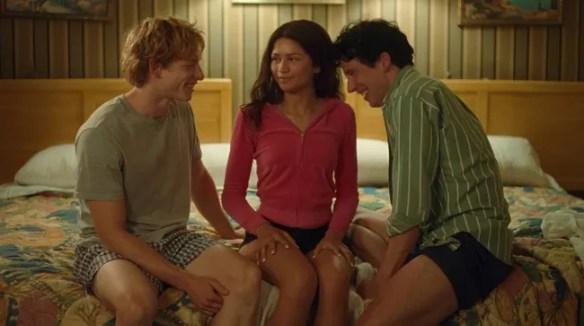
Luca Guadagnino’s new film Challengers has been getting good reviews (trailer). The cast is super: Josh O’Connor, Mike Feist, and Zendaya are the leads. And, if you’re as obsessed with tennis as they are, you may enjoy it more than I did.
The film cuts back and forth from the present, with three aging tennis prodigies. Patrick Zweig (O’Connor) is scruffy and down on his luck or likes to pretend he is—sleeping in his car, cadging meals. Art Donaldson (Faist) is near the top of his game, but faltering, more due to shaky confidence than lack of a serve. Tashi Duncan (Zendaya), a former teen tennis star herself, sidelined by a career-ending injury, is Donaldson’s coach—and wife.
The men were best friends from childhood, inseparable, and “complete each other’s sentences” close. They met Duncan about a decade earlier, both starstruck by her beauty and tennis skills. Then the real competition begins. Over the next decade they play her back and forth like a, well, like a tennis ball, and even though she married Donaldson, it’s just possible Zweig still holds first place in her heart.
The movie cuts between scenes set in the current day, when the men are playing a second-rate match in New Rochelle that both are desperate to win. Zweig needs the cash; and Donaldson needs the win to qualify for the US Open. But what they’re really playing for is Duncan. I get that, but these characters aren’t so interesting as to hold my attention for two hours.
All three of them are master manipulators, but at least O’Connor can take the edge off with his sly smile. You see their practices, their various matchups over the years, and a lot of this final match. Walking out, my bottom line was “too much tennis.”
Rotten Tomatoes critics’ rating: 88%; audiences 73%.










 Right in the middle of Wimbledon’s 150th Championships we scored a Netflix copy of director Janus Metz’s 2017 movie about the classic 1980 matchup between Ice-Borg and the Superbrat, with a script by Ronnie Sandahl (
Right in the middle of Wimbledon’s 150th Championships we scored a Netflix copy of director Janus Metz’s 2017 movie about the classic 1980 matchup between Ice-Borg and the Superbrat, with a script by Ronnie Sandahl ( It might almost be worth seeing the new movie Gotti with a sneering John Travolta in the lead, simply because it has received a (surprisingly) rare “0” rating from Rotten Tomatoes critics. Unanimity about a movie’s goodness or apparent awfulness is so rarely achieved that this may be a cinematic low-water-mark. A filmic Sahara. A future cult classic.
It might almost be worth seeing the new movie Gotti with a sneering John Travolta in the lead, simply because it has received a (surprisingly) rare “0” rating from Rotten Tomatoes critics. Unanimity about a movie’s goodness or apparent awfulness is so rarely achieved that this may be a cinematic low-water-mark. A filmic Sahara. A future cult classic.
 The first question everyone asked when they learned we were going to the Kentucky Derby this year was—“Do you have a hat?!” Yes, I did, and here’s the photo to prove it! It was like wearing a dinner plate on the side of my head.
The first question everyone asked when they learned we were going to the Kentucky Derby this year was—“Do you have a hat?!” Yes, I did, and here’s the photo to prove it! It was like wearing a dinner plate on the side of my head.

